
|
Sale 47
Pre-Long Beach Coin and Currency Auction
| Ohringer Collection $5 Gold |
| |
| |
| Lot |
Photo |
Description |
Realized |
Lot 4408 |
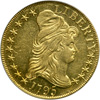 |
1795 $5 Capped Bust. Small eagle. . S over D in STATES. BD-6, Breen-6414. Rarity-5. PCGS graded MS-61. Encased in PCGS holder 50140270. Untoned with semi reflective surfaces. Approximately 60 to 80 examples are known in all grades of the intriguing S over D BD-6 variety half eagle of 1795. Easy identifiers are the flag of the 5 in the date is halfway over the drapery, while the tip of the 1 is free of the curl (only obverse used with this combination). This die pairing is the second, and final, use of the blundered reverse die and is the one most often seen in high grades. However, the shattered state of both dies indicates a single production run for this variety. The damaged dies, according to Dannreuther, account for the retirement, as with all early Mint issues. "This curious reverse die possibly was the result of either alcohol or a late night party, as the die sinker made numerous slips while preparing this reverse," notes Dannreuther, half jokingly. "The spikes from the dentils are also seen on this obverse die, as well as the previous obverse die [BD-5], although they are not as plentiful as seen on the reverse."
What needs to be discussed is the coin's outstanding state of preservation. Well detailed for this more difficult early gold Type, with bright greenish golden color. The color adds considerably to the appeal of the reflective fields and frost-hardened devices. Clockwork precision seen in the detail of the hair and eagle, as well. Full, problem free rims on both sides, no mischief ever occurred to this coin, and even making up for a few slight marks and hairlines, it would be hard to find another similarly-graded example to compete with this coin. Probably the only hope for bidders lies in the fact that courage and determination will see the bidding through to the end. When once we have sold this piece, the sale will verge on history, with limited opportunities to acquire another such specimen. The individual who buys it will give endless enjoyment to his friends by its display and discussion. Pop 18; 47 finer, 29 in 62, 10 in 63, 6 in 64, 2 in 65 (PCGS # 8066) .
Estimated Value $70,000 - 80,000.
Ohringer Family Trust Holdings.
View details and enlarged photos
Check results on similar lots
| Realized
$92,000 |
Lot 4409 |
 |
1803/2 $5 Capped Bust. . BD-1, Breen-6441, Miller-56. NGC graded MS-65. Housed in NGC holder 1719633-027. BD-1, Rarity 4. Only 33,506 pieces struck. A gorgeous well struck gem that glistens with semi-reflective surfaces throughout. We note some faint adjustment marks on the bonnet as made. Nonetheless, easily one of the finest known. An impressive coin that will undoubtedly be well contested.
High on the list of collector favorites are the overdate half eagles struck in 1802 and 1803. A curiosity is that neither year seems to be available without overdate. There were apparently no perfect-dated dies made or used. Pop 2; 1 finer in 66 (PCGS # 8084) .
Die notes: Star near and points to upper beak tip, and is free of ribbon. On the obverse, 3 just free of Liberty's bust, missing right foot of T of LIBERTY. Early die state b (lightly clashed) but no cracks having yet developed. "The terminal state for this reverse should indicate a short production run for this variety," explains Dannreuther, "but this variety is fairly available, over 150 examples still exist."
Estimated Value $100,000 - 110,000.
Ohringer Family Trust Holdings.
View details and enlarged photos
Check results on similar lots
| Unsold |
Lot 4410 |
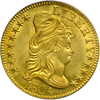 |
1804 $5 Capped Bust. Small 8. . BD-1, Breen-6443, late die state with reverse cud. PCGS graded MS-64. Encased in PCGS holder 21973690. A lovely coin with nice golden toning. The surfaces on this handsome coin are judged by us to be bright yellow to greenish gold in color, and quite lustrous, highly frosted, dramatically so, with the MS64 grade acting on behalf of its outstanding quality. Circumstances with the bloom off the dies being what it is, sharp-edged devices and lettering throughout add immensely to the coin's beauty. 1804 is noted for its sharp, clear detail, and this coin's strike is right up there among the finest seen. BD-1 has several notable identifiers. First is the "normal 8" in the date (formerly a small 8, but it is the correct 8 punch according to Dannreuther). The top of the 1 is blunt missing its flag, like 1800. The 4 is small. On the reverse there is a graver line from the left shield point through B in ribbon, through star 12 to the upper beak.
Those collectors who have a taste for sitting back and watching other people bid, so essential to the genre of this field, will do wise to pick up their bid card (or press the correct computer button) and show their willingness to compete for the honor of possessing this 1804 early half eagle! Pop 4; none finer at PCGS (PCGS # 8085) .
Estimated Value $50,000 - 55,000.
Ohringer Family Trust Holdings.
View details and enlarged photos
Check results on similar lots
| Realized
$51,750 |
Lot 4411 |
 |
1806 $5 Capped Bust. Round 6. . BD-6, Breen-6448, Miller-84, sometimes referred to as "Knobbed 6." NGC graded MS-64. Well struck. Frosty and untoned. A single die par was used to strike the Round Top 6 half eagles of 1806. The coin is by far the most obtainable variety of the six die combinations used to strike the year's coinage. However, that is not to say the availability is widespread in strict Mint State grades. A remarkable coin that emits eye-catching brilliant golden color, with no marks, problems or other caveats for the skeptic to laud over. Bearing that in mind for the mint frostiness, we next describe the transfer from die to planchet; we see as well a full, bold strike notable in the main devices, lacking only some tiny basics in the upper corners of the shield on the reverse, as well as the central stripes thereon. Many do not understand the conditions through which such a coin survived to the present day. Imagine an obstacle course of grubby hands, fumble-fingers, attempts at "improving" the coin through various means only a sinister agent of the underworld could admire. And that is why the resulting population statistics reveal what they do about the survival in Mint State 64 condition: Pop 14; 1 finer in 65. (PCGS # 8089) .
Estimated Value $45,000 - 50,000.
Ohringer Family Trust Holdings.
View details and enlarged photos
Check results on similar lots
| Realized
$48,875 |
Lot 4412 |
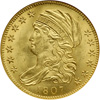 |
1807 $5 Capped Draped Bust. Bust left. . BD-8, Breen-6453, Miller-101 (feather tip points to op of 5). NGC graded MS-65. In NGC holder 1847930-001. BD-8, Rarity 2. Only 32,488 pieces struck. A splendid gem example sharply impressed on a problem-free planchet. Shimmers with undisturbed frosty mint luster. This outstanding Capped Bust Half Eagle glows with light yellow-golden colors. The immensely pleasing color, luster and strike definition combine in this one small gold coin to produce great aesthetic beauty! The average half eagle this year comes to market bearing a world of troubles like dullish luster, hairlines, or too many handling marks. However, the parent of them all has to be the Gem BU example offered here. Everybody wants one. We will say that the most eminent buyer in the room, after the ballet of bidding has ended, will decide the coin's next ownership. Bidding on this coin will require a different sphere for the concentration of the bidder's talents. We expect to see a little drama in the room, in fact, as the bid cards fly and the hands wave. The fine overworked gentleman at the dais will no doubt be left speechless and drained of energy once he calls the final bid to the high bidder. Pop 3; 2 finer in 66 (PCGS # 8101) .
Die notes from the Dannreuther book: "This is by far the most seen variety of the two for this year -- Bass owned four coins of this variety… This is the final use of this obverse, but the reverse die is combined with two overdated and one normal obverse in 1808." (In later years, most dated dies were destroyed after the year ended. By the latter part of the 19th century, this destruction of dated dies was mandated by Mint officials to prevent restriking or overdating of rare issues.).
Estimated Value $80,000 - 90,000.
Ohringer Family Trust Holdings.
View details and enlarged photos
Check results on similar lots
| Realized
$92,000 |
Lot 4413 |
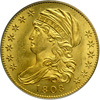 |
1808 $5 Capped Draped Bust. . BD-3, Breen-6456, normal 5D. PCGS graded MS-64 PQ. CAC Approved. Well struck and untoned. Nice eye appeal. Normal spacing with the 5D, the point of a feather virtually centered between the two. A problem-free coin with luster racing over the surface, vivid and frosted in appearance. What's more, the fields acquit themselves nicely in terms of the fewness of marks. Putting aside the luster for a moment, on to the strike. Here again, it is easy to see this piece received a full, sharp blow by the dies. All stars show complete radials and proper star-shape (no flatness). The 13th star has the usual small nick out of one point. Some numismatists suggest this is the secret signature of the die maker, one John Reich, who was in the Mint's employ for the better part of 10 years. Immediately after he left the establishment, the mysterious broken star disappears from our coinage. A wonderful specimen for the advanced collector to add to his collector or portfolio of rare gold coins. Those who seldom miss an opportunity will want to apply their talents to acquiring this coin. Pop 10; 1 finer in 65 (PCGS # 8102) .
Estimated Value $47,000 - 50,000.
Ohringer Family Trust Holdings.
View details and enlarged photos
Check results on similar lots
| Realized
$63,250 |
Lot 4414 |
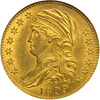 |
1809/8 $5 Capped Draped Bust. . BD-1, Breen-6458, the only die combination this year. NGC graded MS-64. Lovely rich golden toning. A nice frosty coin. Only 33,875 struck. A decidedly beautiful Gem that has radiant golden originality. Struck with systematic exactness throughout the stars and main design elements, there is little reason to ignore the central part of the reverse where, on some dates in the Capped Bust Left series, a severe rounded impression is often left by the dies. This coin is decidedly bold in the centers. And elsewhere. The 1809 Overdate is rooted to its place in history by being the only variety struck this year. Is so happens, the 1809 is the scarcest date of this type as well, a design that lasted only from 1807 until 1812. Curiously, noted gold coin specialist Harry Bass doubted the overdate status, but traditionally it has been accorded that term. Tradition often wins out over form and, as noted in the Dannreuther book of die varieties, the author agrees with Bass, "the overdate status of this variety is very doubtful. There is something under the 9, but whether it is an 8 or remnants of an erroneously punched 9 is uncertain," Dannreuther explains. Pop 32; 10 finer in 65. (PCGS # 8104) .
Estimated Value $45,000 - 50,000.
Ohringer Family Trust Holdings.
View details and enlarged photos
Check results on similar lots
| Unsold |
Lot 4415 |
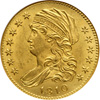 |
1810 $5 Capped Draped Bust. Small date, large 5. . BD-1, Breen-6462, Miller-114. NGC graded MS-64. BD-1. A nice sharp strike with superb detail throughout. The frosty mint surfaces are honey-golden in color, identifiable by a small diagonal mark by the ear. NGC holder 1897701-010. BD-1. The only variety of the year. Only 15,454 pieces minted. A well struck frosty mint example with light clash marks as made. Shimmers with honey-color golden lustre. A marvelous example for the Capped Bust type. The light die clash referred to in the opening comments are visible as the stripes of the shield echoed in Liberty's hair and ear also with light ghosting of the eagle's body around the field of Liberty. There is only the one die pairing this year, with a die center punch lump between curl and ear. Remnants of the earlier 3 are clearly visible at both sides of the top of the 4 and below its crossbar at left, and on both sides of the crossbar at right. The small "chip" out of one star point on star 13 points to John Reich as the maker of this die, since most numismatists agree this could not have happened without the conscious intervention by someone at the Mint. Perhaps as many as 100 examples survive, coins of this popular date/variety are quickly snapped up at auctions and on bourse floors. The reverse used on the 1814 overdates is the second of three uses for this die; the final use with the extremely rare and famous 1815 $5. Pop 4; none finer at NGC (PCGS # 8106) .
Die note: There is confusion about this particular variety, as Breen misidentified the obverse, believing it was identical to the other Small Date obverse used for BD-2. According to Dannreuther, "This variety seems to have been struck on at least two occasions, as the dies are both found without and with rust lumps. This indicates there was a production run, the dies were removed and improperly stored, and then they were used again for other production."
Estimated Value $45,000 - 50,000.
Ohringer Family Trust Holdings.
View details and enlarged photos
Check results on similar lots
| Unsold |
Lot 4416 |
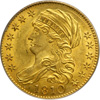 |
1810 $5 Capped Draped Bust. Large date, large 5. . BD-4, Breen-6459. PCGS graded MS-64. A nice frosty example. Famous gold collector Harry Bass liked this variety to the point where he owned four specimens. BD-4 is the most available of the date and type, and is among the most frequently seen varieties of all the early half eagles, according to the Dannreuther reference. The high end of the estimated mintage is 90,000. Somehow the dies remained in great shape without suffering either major injury. Velvety to frosted fields and devices almost stagger under the weight of its highly lustrous golden color. A dash of weakness is seen at the curl above the drapery clasp on most of this issue, but here it is probably that the design were incorrect for better definition, apart to prevent any weak metal flow caused by insufficient die pressure in that area. The designs are very strong for the date, as is the impressive MS64 grade. No sooner has a collector purchased an early Capped Bust gold piece like this than he is ready for another. The misfortune is to not have a sufficient supply to provide nice specimens to all collectors. Pop 33; 2 finer, 1 in 65, 1 in 66 (PCGS # 8108) .
Estimated Value $35,000 - 40,000.
Ohringer Family Trust Holdings.
View details and enlarged photos
Check results on similar lots
| Unsold |
Lot 4417 |
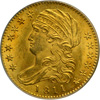 |
1811 $5 Capped Draped Bust. Small 5. . BD-2, Breen-6464. PCGS graded MS-64 PQ. CAC Approved. Lovely rich golden toning. A bold strike. This is the only obverse die used for the year; it is combined with a reverse with small 5 (the same punch as the small 5 of the 1810), though not the identical die. Auction data indicates this variety appears only 25 to 50 percent more often than the large 5 variety, so that neither variety is scarce and both are available (thus affordable to a serious buyer) to appear with frequency at auctions. The toned brilliance of the example we now present bidders beats (from a technical angle) many that have passed through the various grading services. That is to say, this is a carefully made example, with excellent detail to all the important high points. It is just as carefully preserved by the numismatic community. Where sometimes we will be obliged to use cautionary words about "with the possible exception of these regions (standard for the issue)", we are happy to that no such notice is warranted. Everything is outstanding. The consignor of a number of these fine early gold half eagles has a connoisseur's eye for high quality. It shows in this piece! Pop 14; none finer at PCGS (PCGS # 8109) .
Estimated Value $35,000 - 38,000.
Ohringer Family Trust Holdings.
View details and enlarged photos
Check results on similar lots
| Realized
$41,400 |
Lot 4418 |
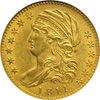 |
1811 $5 Capped Draped Bust. Small 5. . BD-2, Breen-6464, Miller-116. NGC graded MS-64. Well struck with light golden toning. There is a hair-thin line on the neck. The same small 5 punched used in 1810 was used for this reverse, but this is from a different die. Some would place the Tall 5 combination with this obverse (BD-1) to be much scarcer than this variety with the Small 5 reverse. However, auction data indicate the Small 5 appears only 25 to 50 percent more often. Neither is especially scarce in "average" condition, but choice Mint States like the example offered in this lot are scarce. They appear infrequently in auctions. This warmly colored example displays beams of golden metallic detail in virtually all areas. Struck with mathematical precision by the dies. Pop 8; 5 finer; 4 in 65; 1 in 66. (PCGS # 8109) .
Estimated Value $35,000 - 38,000.
Ohringer Family Trust Holdings.
View details and enlarged photos
Check results on similar lots
| Unsold |
Lot 4419 |
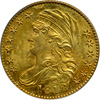 |
1812 $5 Capped Draped Bust. . BD-1, Breen-6466, Wide 5 D. PCGS graded MS-64 PQ. Lovely rich golden colors. A nice frosty coin. The years 1810, 1811, and 1812 provide collectors with the majority of early Capped Bust Left half eagles, with choice specimens being available but by no means common. This handsome MS64 fits the requirement for the grade and, indeed, merits special mention because the luster is so pure, original, and blemish-free. The strike is crisp in most areas, though some lack of detail may be noted at the eagle on the reverse. A few trace adjustment lines visible in the shield and URI of the motto. A small identifier mark in the field rests between S and O(F).
The Wide 5 D variety is the first one listed in the Dannreuther reference as it is the first of two uses for the obverse die which deteriorated over time (but the only use of this reverse, which has the 5 and D strangely separated, as the D is about centered between the 5 and the last A of AMERICA). There are no clash marks, lapping, or die cracks evident, which suggests this is an early state of the dies. Pop 38; 5 finer, 4 in 65, 1 in 66 (PCGS # 8112) .
Estimated Value $35,000 - 38,000.
Ohringer Family Trust Holdings.
View details and enlarged photos
Check results on similar lots
| Realized
$37,950 |
Lot 4420 |
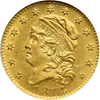 |
1814/3 $5 Capped Head. . BD-1, Breen-6468, Miller-121. NGC graded MS-64. NGC holder 1897701-010. The only variety of the year. Only 15,454 pieces minted. A well struck frosty mint example with light clash marks as made. Shimmers with honey-color golden luster. A marvelous example for the Capped Bust Type. The light die clash referred to in the opening comments are visible as the stripes of the shield echoed in Liberty's hair and ear and also as light ghosting of the eagle's body around the field of Liberty. There is only the one die pairing this year, with a die center punch lump between curl and ear. Remnants of the earlier 3 are clearly visible at both sides of the top of the 4 and below its crossbar at left, and on both sides of the crossbar at right. The small "chip" out of one star point on star 13 points to John Reich as the maker of this die, since most numismatists agree this could not have happened without the conscious intervention by someone at the Mint. Perhaps as many as 100 examples survive, coins of this popular date/variety are quickly snapped up at auctions and on bourse floors. The reverse used on the 1814 overdates is the second of three uses for this die; the final use with the extremely rare and famous 1815 $5. Pop 8; none finer at NGC (PCGS # 8117) .
Estimated Value $45,000 - 50,000.
Ohringer Family Trust Holdings.
View details and enlarged photos
Check results on similar lots
| Realized
$48,875 |
Lot 4421 |
 |
1820 $5 Capped Head. Square base 2. . BD-3, Breen-6476, Miller-129. NGC graded MS-65. In NGC holder 1634525-001. J.D. notes 50-65 examples known in all grades. Boldly struck throughout. A splendid frosty mint gem. Light yellow golden color that deepens slightly about the devices. Incredibly lustrous gem fields with uniform satin frost and the bare minimum of surface marks. Under close inspection, the fields and devices reveal the texture of smooth frosted glass, but of a brilliant golden color, finely granular, pretty as anything imaginable. This specimen is free of toning. It is free of toning spots as well, that bane of all rare high-grade 19th century gold rarities. Identifiers are few and insignificant: a tiny mark in the reverse field below R of PLURIBUS; a small shallow dot below M of AMERICA and a little curled lint mark depression below M of UNUM. As far as the key striking sharpness is concerned, the central devices are finely detailed on both sides, with Liberty's hair curls complete, and crisp details throughout the eagle's feathers, the stripes of the shield, legends, arrow points, and feathers, dentils, etc.
Large letters reverse style with defective Ts, each having a small notch at the right juncture of the foot and stand. An interesting characteristic shared with other reverse dies for this and other years through 1826. No die cracks are seen. Pop 5; 2 finer, 1 in 65 star, 1 in 66 (PCGS # 8125) .
Die notes: on BD-3, star 1 is distant from Liberty's bust, while star 13 is near (but not touching) the curl; an arrow points to the right foot of R on the reverse. A scarce variety, it is the most available Square Base 2 die pairing and for the entire year, as the five varieties of curved base 2 are all rare to exceedingly rare. It is estimated that 50 to 65 are known in various grades, mainly circulated to low-end Mint State. According to Dannreuther, "The reverse die must have suffered a fatal injury, as this was the only appearance. The obverse die remained intact and was used for the next variety (BD-4)."
Estimated Value $80,000 - 85,000.
Ohringer Family Trust Holdings.
View details and enlarged photos
Check results on similar lots
| Realized
$92,000 |
Lot 4422 |
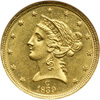 |
1839-C $5 Liberty. NGC graded MS-63. In NGC holder 1846102-002. Only 17,205 coins struck. Unusually sharp strike in natural slightly greenish-color light gold. Splendid with frosty mint luster. The 1839-C Half Eagle is a stand-alone type from the issues of 1840-1865 in the Liberty half eagle series. And it does not take an eagle eye to see the difference, there are many details from Gobrecht's first hub which are plainly evident, while others are not quite so pronounced as the differences since on his 1838-39 eagles. What's more, 1839-C five has the feature of being the only Coronet half eagle with mintmark on obverse.
The usual grade that is offered is Extremely Fine, although a dozen or more About Uncirculated examples are believed to be in collections. When it comes to Mint State coins, the number known dwindles rapidly. This handsome MS63 sets at the high end of the popular Condition Census listing, a subjective yet no less important ranking of surviving specimens. The coin has soft, frosty luster and exhibits light yellow-gold color (Charlotte gold often tests positive for a high silver content with other trace elements in addition to the 90% gold, hence the color-shift). The details on the main relief features are boldly struck on either side. This leaves the viewer wide-mouthed and in awe of the remarkable sharpness found on Liberty's hair and hair bun, on the eagle's feathers and shield, and elsewhere. Identifying marks, while few, can serve as future provenance links: one on Liberty's cheek by the lips, another above the eagle's head at right, a third below O of OF, are three that can be used. Light field abrasions elsewhere fit into the MS63 parameters. To sum it up, this coin has exceptional quality and a well recognized rarity in this grade. These are the NGC census numbers: Pop 2; none finer at NGC (PCGS # 8192) .
Estimated Value $50,000 - 55,000.
Ohringer Family Trust Holdings.
View details and enlarged photos
Check results on similar lots
| Realized
$55,200 |
Lot 4423 |
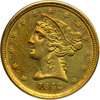 |
1842-C $5 Liberty. Small date. PCGS graded AU-58. Among the finest known of this extremely rare issue. Boldly struck in most areas with attractive light golden toning. A few tiny marks in the field (noticeable more on the reverse) can be ignored when one takes into consideration the degree of originality; nothing at all injures the delicate design features of Liberty. Some stars aren't as well made as others. And as often occurs with this early C-mint date, the rim dentils below the date and to the left are slightly mashed. This carries over to the reverse, but elsewhere, sharpness is maintained. Turning now to the reverse, there is a small mark below the eagle' neck, but this is minor and seeing that the remaining surface easily fits within the AU58 designation for a gold piece of the 1840s, what we find here is almost miraculous. The entire coin is by all measures accurately graded. A treat for any advanced buyer of early date Charlotte Mint gold coinage. Those reviewing the price histories of early Charlotte gold coins in years to come will no doubt refers to this coin's sale. Pop 6; 1 finer in 62 (PCGS # 8208) .
Estimated Value $45,000 - 50,000.
Ohringer Family Trust Holdings.
View details and enlarged photos
Check results on similar lots
| Unsold |
Lot 4424 |
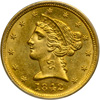 |
1842-C $5 Liberty. Large date. PCGS graded MS-63. Small mark on Liberty's nose. Well struck with nice golden toning. Lustrous medium to warm gold with a tint of olive overtones. A lustrous beauty from the Charlotte Mint. Nicely struck in all places (which is rare). This includes a nearly perfect eagle whose only diminishment is at the neck feathers. An important rarity in such splendid choice Uncirculated condition, much more so than the few others that have been offered in recent years. One of perhaps ten Mint State examples of the date reported, and our estimate may be a trifle high. Douglas Winter gives this date a High Rarity-7 rating in Uncirculated. It is clearly among the most illustrious Charlotte Mint half eagle offerings in this sale. Pop 2; none finer at PCGS (PCGS # 8209) .
Estimated Value $27,000 - 29,000.
Ex: Ashland City Collection Ohringer Family Trust Holdings.
View details and enlarged photos
Check results on similar lots
| Unsold |
Lot 4425 |
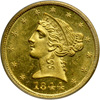 |
1844-D $5 Liberty. PCGS graded MS-64 PQ. CAC Approved. In PCGS holder 05549771. Well struck with nice mint luster evident. This coin has a special look as if it were a specimen strike. The 1844-D has about the same rarity as the 1843-D and 1845-D half eagles, grade for grade, although may be scarcer in high grades. This appears to be the finest known example and it surpasses the Ashland City coin (which has a light scrape that runs diagonally alongside Liberty's nose). The strike is excellent; indeed, incredibly sharp which is why we question whether it isn't some sort of special striking. The obverse is completely detailed with the minor exception of soft rim denticles. So sharp is Liberty's hair that it stands out forcefully like the hair on the later Proofs. One has to look twice at the mintmark to see that it is in fact a D-mint coin. The reverse is similarly detailed. There are a few tiny marks in the field, but Liberty's profile seems to have missed attracting any. The reverse has a few small marks below OF. The luster is outstanding with a mixture of frosty texture and prooflike reflectiveness. There is more than a bit of prooflike surface in the fields. Assembling the pieces, we can say confidently, this is an unusually handsome coin. It's attractions are many. And best of all, it would make a wonderful high grade purchase for an experienced gold buyer. 88,982 pieces minted. Pop 1; none finer at PCGS (PCGS # 8221) .
Estimated Value $30,000 - 35,000.
Ohringer Family Trust Holdings.
View details and enlarged photos
Check results on similar lots
| Realized
$41,400 |
Lot 4426 |
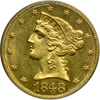 |
1848-C $5 Liberty. PCGS graded MS-64 PQ. CAC Approved. Housed in PCGS holder 03523043. Untoned and well struck. Lots of mint luster still evident. This handsome coin is superior to the famed Elrod Collection specimen in MS64 sold by Heritage in March of 2005. The mintage for the year topped out at 64,472 pieces, making it one of the more abundant Charlotte Mint dates. However, only three or four are believed to be known in Mint State out of a possible census of 150. The coin is well struck and displays original brilliance with a light greenish gold color. What matters is that this is the finest reported by PCGS. (The Elrod specimen, in an NGC holder, has some strike weakness in the centers.) With detail far surpassing anything one might expect for an 1840s decade C-mint half eagle, there is much to say about this outstanding coin. It boasts extremely beautiful, graceful surfaces which are lightly prooflike with contrasting frosted devices. The mint luster seems to glow with unusual intensity. We count 13 full stars, and unlike many others of this year and mint where roundness and flat details occur all the time, the eagle and Liberty's hair above the brow are commendable for their boldness. A case study in Charlotte Mint quality, therefore; check out the photographs to see if we aren't telling it to you straight. Collectors often read their monthly sale catalogs assiduously in the hope of finding a few top-end early gold rarities. Even a cataloger's lightest touch cannot turn a lesser coin into this one, however. If we say a piece is gorgeous, then it is. This coin is gorgeous. Generally it takes a number of bids for such a piece to reach its final auction price, and a couple of rounds around the auction room to do it, but it cannot escape the record books once the final price is hammered down. We expect the price realized to set a record. Pop 1; none finer at PCGS (PCGS # 8237) .
Estimated Value $50,000 - 55,000.
Ohringer Family Trust Holdings.
View details and enlarged photos
Check results on similar lots
| Realized
$71,875 |
Lot 4427 |
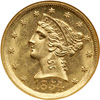 |
1854-D $5 Liberty. Medium D. NGC graded MS-65. Only 56,413 coins minted. A bold strike with a nice deep impression. Frosty mint luster. Pale yellow gold color. Winter 24-R. In describing this almost indescribably beautiful Gem BU 1854-D half eagles, the Ashland City cataloger figuratively gave it two thumbs up when he wrote (using his other eight fingers): "This spectacular coin is unlisted on Doug Winter's Condition Census. It is neither the Milas nor the Byron Reed specimen. As such, it will most likely find its place as the #2 coin on the C.C. as the #1 coin is described as, "The Akers plate coin and…one of the two finest known Dahlonega half eagles of any date." This is one of the seldom encountered pieces that is fully struck throughout. The surfaces are bright and highly lustrous with shimmering mint frost that is intermixed with prooflikeness which resulted from the coin having been struck from striated dies. Bright orange-gold color, there are only the tiniest imperfections evident on either side of this impressive Gem Five Dollar from the historic Dahlonega mint." Pop 1; 1 finer in 67 (PCGS # 88258) .
Estimated Value $65,000 - 70,000.
Ex: Ashland City Collection, Heritage 1/2003:4785 Ohringer Family Trust Holdings.
View details and enlarged photos
Check results on similar lots
| Unsold |
Lot 4428 |
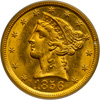 |
1856-D $5 Liberty. PCGS graded MS-64. Encased in PCGS holder 50150971. Lovely rich golden toning. Only 19,786 pieces struck. In 1839, the design of the half eagle was changed from the Classic Head to Christian Gobrecht's long-lasting Liberty Head design. By 1856, the Dahlonega, Georgia Mint, which went into business in 1838, had acquired extensive knowledge and experience striking gold coins from locally mined materials as well as from gold rush bullion shipped back East. Yet it never ceases to amaze us when a vibrant, frosty specimen such as this comes along. For the coin is, without question, one of the finest known 1856-D fives ever offered. It's luster compares favorably with the luster found on any early 20th century BU half eagle. It's sheen sublime; and beautiful toning will make you cry for joy, or, if gushing tears aren't in your nature, then you will surely stop and pause to stare in appreciation of such a marvel. Sharply struck around the peripheries, there is the normal slight weakness evident on Liberty's hair curls and at the eagle's neck. These pretty much dominate the way Dahlonega struck gold half eagles look from the 1850s. The frosted surface is extraordinarily vibrant. What's more, the luster is free from any distractions, detractions, disturbance. Instead, the fields prove once again that when it comes to careful acquisition talents, our consignor picked a winner! Now it is your turn to do the same. Pop 3; none finer at PCGS (PCGS # 8268) .
Estimated Value $40,000 - 45,000.
Ohringer Family Trust Holdings.
View details and enlarged photos
Check results on similar lots
| Realized
$44,850 |
Lot 4429 |
 |
1856-D $5 Liberty. PCGS graded MS-63. Warm golden toning on both sides. Softly struck but loaded with mint lustre. Great eye appeal. Only 19,786 minted. From the same acquisition as the previous MS64 example, and featuring similar vibrant luster, color, and strike character. These two lay hidden away for more than a century before they made it into the light of day once again. We praise this coin's survivability. Few have have had the stamina to have retained any mint luster, let alone such booming luster. The time to bid is at hand. Once it is over, then will come the time to uncork the champagne bottle when you succeed in acquiring this lot. The lucky person who puts this 1856-D half eagle in his collection will be the talk of the town. Pop 3; 3 finer in 64 (PCGS # 8268) .
Estimated Value $30,000 - 35,000.
Ohringer Family Trust Holdings.
View details and enlarged photos
Check results on similar lots
| Unsold |
Lot 4430 |
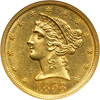 |
1858-C $5 Liberty. NGC graded MS-63. NGC holder 1719177-005. Needle sharp! Slight roughness in the planchet (see below). Reflective mint luster throughout. Only 38,856 coins minted. A hint of weakness at that is typically seen on 1858-C half eagles (those of lesser quality, we must remind readers) is entirely missing on this remarkable specimen, with the key central areas strongly hit by the dies. Sometimes it seems the Mint just dashed-off the stuff without keeping track of the quality. In other words, either lack of initiative (or more logically, lack of talent) by the mint staffers tended to produce less that full strikes. That isn't the case here. A beautiful golden-bright coin with no objectionable marks or blemishes other than for some slight roughness in the surface or planchet on the reverse field as struck. Words are inadequate to describe the reward the successful bidder will receive when he lands this half eagle, for it stops just shy of Finest Certified quality, indicated here: Pop 2; 1 finer in 64 (PCGS # 8277) .
Estimated Value $25,000 - 30,000.
Ohringer Family Trust Holdings.
View details and enlarged photos
Check results on similar lots
| Unsold |
Lot 4431 |
 |
1859-C $5 Liberty. PCGS graded MS-63. In PCGS holder 3423673. Nicely toned. Only 31,847 pieces minted. Lustrous smooth surfaces exhibit warm toning iridescence in all areas. The usual stray marks on the face are totally absent here, which makes us think the grading service was being extra conservative in its appraisal of the condition. Liberty's detail is razor-sharp. The reverse strike is more typical for 1859-C with softness in most places as though the die were beyond its usual date for retirement. Yet this is definitely one of the best high-end specimens around, no two ways about it. The overall quality of the obverse especially commends the coin to bidders. The low mintage was further reduced through exporting (during the Civil War), hoarding and eventual loss or melting, so that most of the specimens found in collections from that era are no better than Very Fine or, sometimes, Extremely Fine. Pop 1; 1 finer in 66 (PCGS # 8281) .
(The reverse of most known 1859-C half eagle is weak. Many of the known specimens from the die also show signs of die rust. This reverse die was also used to strike 1860-C half eagles.).
Estimated Value $35,000 - 37,000.
Ohringer Family Trust Holdings.
View details and enlarged photos
Check results on similar lots
| Realized
$35,650 |
Lot 4432 |
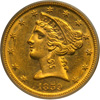 |
1859-D $5 Liberty. Medium D. PCGS graded MS-63. In PCGS holder 51050972. Nice golden toning. Only 10,366 struck. The surfaces are radiant with each side displaying a nice veneer of warm orange-gold patina. The color seems to whip and toss about as it alternates between lighter and deeper shades. What we first notice is its bold detail. All too infrequently does one encounter a half eagle made in Dahlonega struck with such fine detail to all the high points. There is only some minor absence of detail in the eagle's neck and right leg feathers (hardly earth shattering). Surfaces are virtually immaculate for a Mint State 63 1859-D. If a search had to be made, perhaps a few light contact marks could be picked out on the eyebrow and elsewhere. But these are so negligible as to be forgotten. A wonderful example of this rare D-mint half eagle, one of the finest certified. Pop 3; 1 finer in 64. (PCGS # 8282) .
Estimated Value $32,000 - 35,000.
Ohringer Family Trust Holdings.
View details and enlarged photos
Check results on similar lots
| Realized
$33,350 |
Lot 4433 |
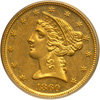 |
1860-D $5 Liberty. Medium D. PCGS graded MS-62. Fresh golden toning. Well struck. PCGS holder 5549789. Of the 14,635 coins made this year possibly as few as 175 may be known today, primarily in circulated condition. The coin's obverse is slightly concave in appearance with the obverse rim protecting than fields and devices. Some minor weakness can be seen, but only on the reverse, and again, only where the eagle's neck feathers are compressed together instead of being revealed separately. But this is all, for the wings, the shield (for the most part), the legs and claws and other ornaments are quite clearly defined. On the obverse, the coronet and hair curls, and beaded cord on the bun at the back of the head are all exemplary in their detail. Considering the usual 1860-D, the reverse is very sharp as it also has less of a concave appearance.
Since most 1860-D half eagles are heavily marked, we are pleased to see this one shows similar exemplary quality in luster that is excellent with a nice frosty sheen. Best of all, so clean is this specimen that there are no defining marks or hairlines to use as pointers, so we'll just "point" to the sleekness and high quality as the defining feature. A very rare coin in this solid, strictly graded condition! Pop 6; 1 finer in 64. (PCGS # 8286) .
Estimated Value $18,000 - 20,000.
Ohringer Family Trust Holdings.
View details and enlarged photos
Check results on similar lots
| Unsold |
Lot 4434 |
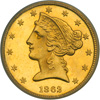 |
1862 $5 Liberty. PCGS graded Proof 63 Deep Cameo PQ. CAC Approved. Lovely rich golden toning. Only 1 example graded in Deep Cameo at PCGS. Only 35 pieces struck. As certain as night begets day, the 1862 Proof half eagle is a coin that is rare in both coining formats, not only as a Proof, but also as a business strike. Its rarity is beyond reproach since as a Proof, only 35 pieces were struck for collectors! Survivors might almost be counted on the fingers of both hands. In the 1982 Eliasberg catalog, Bowers opined that "only a dozen or so can be traced," and Breen (1988) estimated that "fewer than 12 are traceable." We believe there may be collectible only 8-10 pieces today, excluding those in museums.
Proofs were struck on February 16, 1862, and this piece, as with all Proof 1862 fives, shows a diagnostic dot near the center of the shield. It has razor-sharp details and smooth, swirling reflectiveness in the field on both sides. Just a few hairlines show while the devices are covered in micron-fine satin frost. The devices display rich mint color giving the coin a pronounced beauty surpassing its modest numerical condition. Collectors of Proof gold will want to follow it closely on the auction block, as it may be many auction cycles before another such opportunity will present itself. Pop 1; none finer at PCGS (PCGS # 98452) .
Estimated Value $30,000 - 35,000.
Ohringer Family Trust Holdings.
View details and enlarged photos
Check results on similar lots
| Realized
$63,250 |
Lot 4435 |
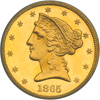 |
1865 $5 Liberty. PCGS graded Proof 64 Deep Cameo PQ. CAC Approved. In PCGS holder 21600816. Lovely rich golden toning. Only 25 pieces minted. With the Civil War still raging in the early months it was a tumultuous time to sell Proof 1865 gold coins to collectors. 1865 has long been considered a very rare coin. Opinions vary but are now centered on the possibility that only 8-10 pieces are left from the original mintage in all grades. This fine example is one of the few we have offered for sale. A bold Proof 63, both sides earn their stripes from the warm orange color atop nicely reflective surfaces. At indirect angles, the fields show off the typical Proof "orange peel" effect, accented by frost on the devices to give two-tone contrast. The mint worked hard to produce the bold strike shown in the photos: full for the times, a treat for anyone to study with a magnifying glass. As far as handling marks go, there aren't any. A few hairlines are visible, all of them minuscule. Put them together an the coin's powerful features pretty much sell themselves. Pop 3; none finer at PCGS (PCGS # 98455) .
Estimated Value $40,000 - 50,000.
Ohringer Family Trust Holdings.
View details and enlarged photos
Check results on similar lots
| Realized
$63,250 |
Lot 4436 |
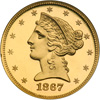 |
1867 $5 Liberty. NGC graded Proof 65 Ultra Cameo. In NGC holder 1633438-003. Only 50 proofs struck. A brilliant glittering gem! Only 3 examples graded in Proof Ultra Cameo at NGC. Identifiable by a small flake in the mirror surface near the dentils by star 9. Brilliant and refreshingly clean for this issue, with flickering golden luster in the fields and sun-gold devices. The cameo frosted contrast is absolutely snappy! Turning next to the fields, these are watery, unbridled with the usual small copper staining spots, and give much eye-appeal, hence the Gem Proof 65 grade assigned by the grading service. Fully struck as on the few others that have come down to us in the 21st century, the Proofs are normally found carefully made since they were the numismatic ambassadors of the United States Mint. A glow of honest envy fills many bidders at the sight of an early Proof half eagle like this. The fact is, only one high buyer can walk away from the sale possessing it, that is the rule. But every other underbidder leaves thinking "what if" as he exits the room after the sale. Pop 1; none finer at NGC (PCGS # 8462) .
Estimated Value $50,000 - 55,000.
Ohringer Family Trust Holdings.
View details and enlarged photos
Check results on similar lots
| Realized
$71,875 |
Lot 4437 |
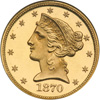 |
1870 $5 Liberty. NGC graded Proof 66 Cameo. Housed in NGC holder 1551341-004. Brilliant untoned golden surfaces. A very rare date in the long Liberty Coronet half eagle series that spans the years 1839 to 1907. The 1870 issue had for decades certainly been overlooked by specialized collectors (although a few wise "name" collectors from the last century saw its potential). Today, the 1870 Proof is widely recognized for what it is, an opportunity that should not be ignored! Only 35 Proofs were originally sold to collectors, and while Akers and others fail to give indication for the numbers of survivors, Breen estimates that perhaps a dozen survive today. We believe there may be even fewer than a dozen, and we quote Akers concluding comment about this date, "…very rare and for some unknown reason [1870 Proofs] have appeared at auction less often than similar or lower mintage Proofs of many other dates." When one turns to the certification services, their data further reinforces this belief as most have been certified no higher than Proof 63 or Proof 64 by PCGS or NGC.
Included in the short roster are: (1) Scanlon:2334 (Stack's 10/73), described as "flawless," and bringing $4,400. Later this piece appeared in Bowers' 11/2000 Bass IV:504 where it was graded PCGS Proof 64 (2) Garrett 3/76:430, realized $5,000, possibly reappearing in Bowers 9/95:1418, again as PCGS Proof 64 (3) Carter:683, $13,200 (4) Clapp, Eliasberg, Trompeter (5) Heritage 8/95:7818, PCGS Proof 63 with several lint marks in lower left of reverse, $17,600. The Trompeter coin, not auctioned at the time (only the gold dollars through $4 gold pieces were sold in 1992) later was placed by private treaty. This gorgeous Gem Proof 66 Cameo specimen may even be the Clapp, Eliasberg, Trompeter piece reappearing after many years. A candidate for "Finest Known". Pop 1; none finer In fact NGC reports the second finest graded as Proof 64 (PCGS # 8465) .
Estimated Value $65,000 - 75,000.
Ohringer Family Trust Holdings.
View details and enlarged photos
Check results on similar lots
| Realized
$92,000 |
Lot 4438 |
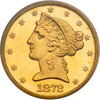 |
1872 $5 Liberty. PCGS graded Proof 65. In PCGS holder 4882870. Lovely rich golden toning. Only 30 pieces struck. Extreme rarity is the order of the day with a Proof 1872 half eagle. Whether a business strike or a Proof, in fact, the extraordinary rarity lies at this coin's doorstep! As few as 12 to 15 Proofs are all that remain in all grades, many of them not so nice. Over the decades we have only handled a couple of other specimens. To give a comparison, the famed Eliasberg-Trompeter Proof 1872 graded a 63! This is one of the finest Proofs in existence and tied for top honors in the PCGS roster. The fields have an infinite depth in their mirrors, reflectivity whose gleam switches back and forth when the coin is tilted under a strong light. The germane feature of the devices, of course, is their razor-sharpness. There are no detracting blemishes, just a few scattered hairlines requiring magnification. Pop 3; none finer at PCGS (PCGS # 8467) .
Estimated Value $50,000 - 55,000.
Ohringer Family Trust Holdings.
View details and enlarged photos
Check results on similar lots
| Realized
$63,250 |
Lot 4439 |
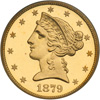 |
1879 $5 Liberty. PCGS graded Proof 65 Cameo PQ. CAC Approved. PCGS serial #12805091. A blazing untoned gem. Only 30 proofs struck. Proof gold coins from the Civil War decade through to the 1880s and beyond have uniformly low survival ratios. Of course, all are rare since they were minted in small numbers. 1879 is an example of this, one of those rare dates everybody talks about but no one seems to remember seeing for sale. It isn't exactly on a par with 1877 and 1878, however the 1879 is we think is as elusive if not more so. From the original mintage, and it is a reliable guess that as of 2008 possibly as few as 10 or a dozen individual specimens exist. A resplendent Gem Cameo Proof, this is the finest PCGS graded example, with no others in its category. The surfaces have sleek bright color and are deeply mirrored with a full quotient of frost over the Liberty head and eagle as well as on top of the stars and letters. This noticeable cameo frost, when combined with the depth of mirrors on each side, leaves vivid impression on the mind of the collector. Examination with a loupe shows only a smattering of very light hairlines, none are major enough to deserve mention. Gem quality of this caliber is important in a 19th century gold coin, contributing to that emotion of thoughts which supply the vigor in bidders to "go for the gold" to borrow a phrase familiar to most of us. Pop 1; None finer at PCGS. Just recently added to the PCGS Proof Population Report. (PCGS # 88474) .
Estimated Value $45,000 - 50,000.
Ohringer Family Trust Holdings.
View details and enlarged photos
Check results on similar lots
| Realized
$60,375 |
Lot 4440 |
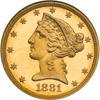 |
1881 $5 Liberty. NGC graded Proof 65 Cameo. NGC serial #1822314-007. Light golden toning. 42 proofs struck. Dazzlingly brilliant and reflective orange-gold fields with lovely "orange peel" surface visible at certain angles. The obverse and reverse offer full cameo contrast, with the obverse a trifle more intense in that respect. A notable rarity. While few Proofs of the date were sold -- in sets on February 19, 1881, with two additional pieces later in the year -- it is doubtful if more than a dozen of those are in existence today. It is not at all likely that all sets found buyers; probably they didn't. Furthermore, of the extant specimens of the Proof 1881 Liberty five, a number are impaired. The present piece is one of the finest bidders will ever see offered for sale, and is among the nicest to come on the market in years. A Proof half eagle rarity that will no doubt bring forth strong bidding response. Pop 3; 4 finer; 2 in 66; 2 in 67. (PCGS # 88476) .
Estimated Value $34,000 - 35,000.
Ohringer Family Trust Holdings.
View details and enlarged photos
Check results on similar lots
| Unsold |
Lot 4441 |
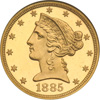 |
1885 $5 Liberty. NGC graded Proof 64 Ultra Cameo. NGC serial #1500894-010. Well struck and untoned. 66 minted. Bright golden color graces the surface of the obverse and reverse, accenting the "ultra" frosted lettering and devices. This coin retains infinite eye appeal and virtual-gem surfaces in every way. For identification purposes, there is a short tone streak or drift mark on the left side of the reverse running on the diagonal. (Other specimens reported of the 1885 issue have similar drift marks.) According to a researcher at Stack's "the Philadelphia Mint achieved the fashionable orange-peel fields through a secret process. This is quite remarkable to study, the fields appear perfectly reflective to the unaided eye, but when a magnifier is used, the fields break up into tiny interlocking facets which have an appearance similar to sun dried mud which has cracked into millions of fragments. This coining technique was perfected on Proof gold coinage of the period, and probably involved a combination of striking pressure and highly polished dies (on the fields), while the devices and lettering were frosted using a short acid bath to create the textured or frosty appearance. The combination of the frosted devices and mirror fields produces the Cameo effect, which is quite strong on the first few coins struck from the dies…" It is definitely "ultra" as seen on the present coin! A marvel of coin manufacture. Very few certified: Pop 2; 5 finer; 3 in 66; 2 in 67. (PCGS # 8480) .
Estimated Value $18,000 - 20,000.
Ohringer Family Trust Holdings.
View details and enlarged photos
Check results on similar lots
| Unsold |
Lot 4442 |
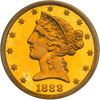 |
1888 $5 Liberty. PCGS graded Proof 65 PQ. CAC Approved. In PCGS holder 5652700. A nice cameo effect. A magnificent gem glowing with intense golden hues. Only 95 struck. Rich orange-gold toning overlays the surface of the obverse and reverse, accenting the razor-sharp lettering and devices on this true Gem Cameo Proof of 1888. This coin retains incredible aesthetic appeal from this combination of color and surfaces, plus the outstanding surfaces are superior in every way. For identification purposes, there is a little toning spot adjacent to the first star. This coining technique was perfected on Proofs early on. By the 1880s, the coins being sold by the mint were works of art. The number of survivors, however, from the original production is all to few to meet potential demand, and so the price must adjust accordingly to the floating supply. Which is why we encourage strong bids, since this ex Harry Bass 1888 half eagle could very well produce a runaway bid. Pop 3; none finer at PCGS (PCGS # 8483) .
Estimated Value $25,000 - 28,000.
Ex: HW Bass Jr. Collection; Ohringer Family Trust Holdings.
View details and enlarged photos
Check results on similar lots
| Realized
$35,650 |
Lot 4443 |
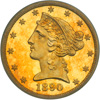 |
1890 $5 Liberty. PCGS graded Proof 65 Deep Cameo. In PCGS holder 22094448. Finest Certified Deep Cameo at PCGS. Only 88 proofs struck. Lovely shades of golden toning on both sides makes this a glowing sun-drenched example with remarkable qualifications in all regards: The fields display smooth reflection, while the contrasting devices are of a frosty consistency. There are no overt hairlines nor are there any contact marks, which is a major plus for top-end buyers; what's more, the cameo contrast is pronounced on this specimen. Whatever else may be the case, the true scarcity of similar dated business strikes should further increase the appeal of this half eagle among sophisticated collectors. Pop 1; none finer at PCGS (PCGS # 98485) .
Estimated Value $30,000 - 35,000.
Ohringer Family Trust Holdings.
View details and enlarged photos
Check results on similar lots
| Realized
$35,650 |
Lot 4444 |
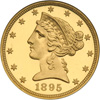 |
1895 $5 Liberty. NGC graded Proof 67 Ultra Cameo. NGC serial #1827382-008. A blazing golden gem. Well struck and perhaps the finest known. Only 81 proofs struck. Incredible glass-smooth mirror fields highlight the perfection of the finely frosted reliefs that appear suspended above them. The obverse fields offers a flavor of the orange-peel texture generally identified with later Proof dates after the turn of the century. The sharpness of the strike may be gauged by the Proof surface within the stripes of the reverse shield. With a Proof mintage of only 81 pieces, this date is outstandingly rare by any measure. In this superlative Ultra-Cameo quality, however, the coin is rarer yet.
The Dannreuther-Garrett 10-year auction record lists 10 appearances of 1895 Proofs, only one described as Proof-67 CAM. The NGC Census Report notes that while five Ultra-Cameo pieces have been certified, exactly one has been certified as Superb. A more perfect example of Liberty Proof Gold would be difficult to imagine. NGC Proof 67 Ultra Cameo. Pop 2; None finer at NGC. (PCGS # 8490) .
Estimated Value $60,000 - 70,000.
Ohringer Family Trust Holdings.
View details and enlarged photos
Check results on similar lots
| Realized
$80,500 |
Lot 4445 |
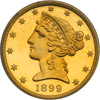 |
1899 $5 Liberty. PCGS graded Proof 64 Deep Cameo PQ. CAC Approved. A hint of light golden toning. 99 proofs struck. Just recently added to the PCGS Population Report. A strikingly beautiful, absolutely splendid Gem Proof 1899 Half Eagle that was saved in very limited numbers, many of which were mishandled in the intervening years. The coin has warm patina throughout the main areas of the fields and devices, toning that takes many decades to develop. There is much here that differentiates this choice Proof 64 from run-of-the-mill Proofs, and the remarkable quality and appearance give it special allure. A coin ringing with words like "beautiful," "sparkling," and "virtually second to none." Which segues nicely into the numbers provided by the grading service: Pop 1; 2 finer in 66. (PCGS # 98494) .
Estimated Value $12,000 - 14,000.
Ohringer Family Trust Holdings.
View details and enlarged photos
Check results on similar lots
| Realized
$17,825 |
Lot 4446 |
 |
1901 $5 Liberty. PCGS graded Proof 66 Deep Cameo. Lovely rich golden toning on both sides. Encapsulated in PCGS holder 50146508. Just about any $5 Liberty Proof gold piece fits the Rare classification in Proof 65 condition or higher. For plain reasons, the Mint never made many of them and few collectors hold any in high grades. This exquisite high-end piece is so vibrant it would illuminate a darkened room! It has reflective surfaces that are deep as a Black Hole in the cosmos. It has beautiful contrast from the frosted relief. Considering most coins after 1900 have very little cameo frost, this specimen is nothing short of miraculous! There is no haze on the mirrors and they are nearly free of hairlines as well. Spot-free perfection gives Liberty and the other details that "perfectly struck" appearance, with thick bright yellow golden frost. We expect this coin will provide an incredible opportunity for any collector seeking an eye-popping Proof Liberty Half Eagle to headline his collection. Only 140 proofs struck. Pop 1; none finer at PCGS. Only 3 PRDCAM examples graded by PCGS (PCGS # 98496) .
Estimated Value $40,000 - 45,000.
Ohringer Family Trust Holdings.
View details and enlarged photos
Check results on similar lots
| Unsold |
Lot 4447 |
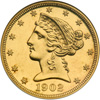 |
1902 $5 Liberty. NGC graded Proof 66 Cameo. A nice untoned example. Only 162 Proofs struck. If one were looking for a heroic coin to add to a set of rare United States gold, this 1902 Liberty half eagle would stand in the front echelon of those in contention. It is anchored by razor-sharp detail, glowing-fresh mirror fields, strong cameo contrast (unusual, for the typical 1902 is struck from "all brilliant" dies), and best of all, superlative condition. Just as a good stage number requires an actor who can sing, dance, be funny, and carry a love scene with believability, so too a pedigreed coin requires certain virtues that this sterling example displays in profusion! Pop 4; None finer at NGC. (PCGS # 8497) .
Estimated Value $32,000 - 35,000.
Ohringer Family Trust Holdings.
View details and enlarged photos
Check results on similar lots
| Realized
$36,800 |
Lot 4448 |
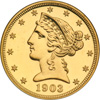 |
1903 $5 Liberty. NGC graded Proof 67 Ultra Cameo. In NGC holder 1891215-003. A well struck untoned gem. Among the finest known. 154 proofs struck. Bright and lustrous reddish gold with swirling deep mirrors and incredibly frosted motifs combining here in a strong way the kind of ultra contrast that collectors go for. (Beginning in 1902 and continuing into 1903, the sunken areas of the dies were also polished by mint employees, and nice frosted cameos from this year are elusive.) We heartily agree here that few survivors from the Proof mintage for this date are equal to the splendor of the present coin. Indeed, few others are in the roster (listed at the end of this description). To sum it up, this exquisite gem is both exciting and captivating when surveyed first-hand, and we to pursuade all interested bidders, even those who do not collect Proof Liberty half eagles, to enjoy a casual few minutes with this lovely cameo gem. Pop 4; 1 finer in 68. (PCGS # 8498) .
Estimated Value $50,000 - 60,000.
Ohringer Family Trust Holdings.
View details and enlarged photos
Check results on similar lots
| Realized
$60,375 |
Lot 4449 |
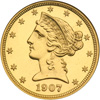 |
1907 $5 Liberty. NGC graded Proof 67 Cameo. In NGC holder 1916233-001. A well struck untoned gem coin. Among the finest known. 92 Struck. This is a rare issue, even by the standards of 19th century Proof gold, with survivors seen with much less frequency than those of the 1900-1906 Proof deliveries. The number struck seems to be a fairly large number, and yet either many examples were melted as unsold at year's end, or a not insignificant number of pieces were lost or spent by collectors. Solidly graded as a Superb Gem Proof 67, this boldly contrasting survivor is at the far North Pole of the Condition Census, in the frozen inner circle where there is only a single other like it (see below). There is not a single distracting blemish on either the obverse or the reverse, no copper spots. Furthermore, both sides are about as close to perfection as one could look forward to in a Proof gold coin of any denomination and issue. Unbelievably deep in reflectivite sheen, the watery fields support textured (frosted) devices with needle sharp delineation throughout. A yellow-gold specimen with breathtakingly gorgeous eye appeal and faultless technical merits. Pop 3; 1 finer in 67 Star. (PCGS # 8502) .
Estimated Value $50,000 - 60,000.
Ohringer Family Trust Holdings.
View details and enlarged photos
Check results on similar lots
| Realized
$54,625 |
Lot 4450 |
 |
1907 $5 Liberty. NGC graded Proof 66 Cameo. A glittering Gem Proof. Only 92 Proofs minted. Let us not blame Fate for leaving numismatics so few top-quality Cameo Proof gold pieces. It was written the day this coin was made that there would be few survivors, let alone a coin as spectacular in its features at this one is! Whichever pressman struck it on the Mint's special medal press (where all Proof gold coins are struck, to insure proper die pressure), he followed his trade nobly. We present what can only be described as one of the top six coins certified by the grading service. Fresh-as-a-morning crispness leaps to the viewer's eye of nearly pristine watery fields supporting just as bold frosted devices. Something for the connoisseur. Pop 6; 5 finer; 1 in 66 Star; 3 in 67; 1 in 67 Star. (PCGS # 8502) .
Estimated Value $35,000 - 40,000.
Ohringer Family Trust Holdings.
View details and enlarged photos
Check results on similar lots
| Unsold |
Lot 4451 |
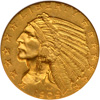 |
1909-O $5 Indian. NGC graded MS-64 PQ. Housed in NGC holder, serial number 3151782-005. Well struck in honey color gold. A Premium Quality example for the grade. The key coin in the series. One of the finest known and a candidate for an upgrade. Only 34,200 struck. The surfaces are radiant and each side has a nice veneer of natural patina from its sojourn through 99 years of American history! The satiny luster, rather than whipping and tossing in the frosty frivolity seen on the Liberty head half eagles, displays alternate shades of sedate, persuasive satin to velvety smooth finish, between lighter and darker shades as the toning exposes the underlying surface under direct light. The grade explains in part this coin's superiority: far in advance of other 1909-O Indian fives as the luster goes, so too are the designs. The designs (or devices if you will), are boldly struck in all areas with pinpoint detailing an the mintmark, the headdress feathers, and throughout the eagle and its claws. When bidding begins, those who are not bidding should watch closely those who are (not to make them self-conscious, you understand). Watch them squirm a little in their chairs as the bidding rises and the tempo of bidding increases, watch their foreheads grow beady with sweat (or is that a spreading gray at the temples?) when the understanding dawns that unless a bold courageous bid is given to the auctioneer, all will be for naught. Pop 14; 2 finer in 65 (PCGS # 8515) .
Estimated Value $150,000 - 175,000.
Ohringer Family Trust Holdings.
View details and enlarged photos
Check results on similar lots
| Unsold |
Lot 4452 |
 |
1910 $5 Indian. NGC graded Proof 66. Well struck and untoned. 250 struck. The surfaces of this lovely Indian five are of the traditional "Roman" finish seen on Proofs from 1909 and 1910. Each side has a satiny allure. The finish is bright and the individual surface construction finer than on the sandblast Proofs from 1908 or 1911-15. Sleek brilliant golden color is seen over both obverse and reverse and, of course, the details in the strike are competently well brought up in all key locations. Examination of the NGC Census Report shows the following: Pop 7; 6 finer; 4 in 67; 2 in 67 star. (PCGS # 8541) .
Estimated Value $35,000 - 40,000.
Ohringer Family Trust Holdings.
View details and enlarged photos
Check results on similar lots
| Realized
$40,250 |
Lot 4453 |
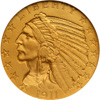 |
1911 $5 Indian. NGC graded Proof 68. In NGC holder 2019388-002 A wonderful Matte Proof gold coin. Perhaps the finest known. 139 struck. This example is phenomenal for its sharp strike. Nearly all matte or sandblast Proof gold issues are, but few can hold a candle to this exquisite specimen. The surfaces have a microscopically grainy appearance with myriad points of tiny bright facets. So perfect is it that the coin is pretty much "as struck," what's more, the surfaces are devoid of any blemishes or handling sings. There are no copper spots. This half eagle is positioned perfectly to attract the most sophisticated buyer. We expects considerable activity today because of the strong gold market and also a stronger than usual market great American gold rarities
The Indian design half eagles, along with quarter eagles, eagles, and double eagles of the same 1908 to 1915 period were all designed at the Mint following suggestions by Bela Lyon Pratt. The Mint in Philadelphia was experimenting with different coin styles at the time and grabbed onto Pratt's "recessed relief" idea of sinking the design below the surface of the coin. Types of finish for Proof coins were also experimental in this period, ranging from satiny bright (the so-called Roman finish of 1909-10) to varying stages of sandblast (1908 and 1911-15) for the various gold denominations, not only the five-dollar pieces. Pop 4; None finer at NGC. (PCGS # 8542) .
Estimated Value $70,000 - 80,000.
Ohringer Family Trust Holdings.
View details and enlarged photos
Check results on similar lots
| Unsold |
Lot 4454 |
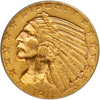 |
1911-D $5 Indian. PCGS graded MS-64. Light even toning on both sides. Struck in the revolutionary "recessed relief" style of other 1908-29 half eagles, the mintmark on the coin is well defined. The balance of the devices are also sharp with clearly separated feathers in the bonnet and on the eagle's wing. The luster displays typical frosty, somewhat granular texture of the period, with suggestions of natural toning. The number of abrasions is minimal, while the overall impact on the visual sense compares favorably with some Indian $5 gold pieces we have seen in higher grades.
Mintage came to just 72,500 pieces, with the 1911-D considered to be among the rarest 20th century gold coins in grades above the Mint State 63. Pop 12; 2 finer in 65 (PCGS # 8521) .
Estimated Value $40,000 - 44,000.
Ohringer Family Trust Holdings.
View details and enlarged photos
Check results on similar lots
| Realized
$50,600 |
|
|